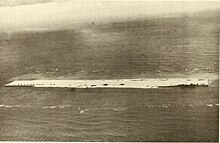
Baker Island, once known as New Nantucket in the early 19th century, is a small, uninhabited atoll located just north of the Equator in the central Pacific Ocean, approximately 1,920 miles southwest of Honolulu. Positioned almost halfway between Hawaii and Australia, its closest neighbor is Howland Island, situated 42 mi (68 km) to the north-northwest. Both Baker and Howland Islands have been claimed as territories of the United States since 1857, though the United Kingdom regarded them as part of the British Empire between 1897 and 1936 but did not actually annex them. They were not being used when a U.S. Colonization attempt was started in 1935, and the next year formal reassertion of U.S. sovereignty was issued. During WWII the Japanese Empire attacked the island, and it was evacuated and a small military base was established. The island was an important navigation beacon in the remote Pacific waters during and after WWII. In the 1970s it was made into a nature preserve and has remained so into the 21st century.

Midway Atoll is a 2.4 sq mi (6.2 km2) atoll in the North Pacific Ocean. Midway Atoll is an insular area of the United States and is an unorganized and unincorporated territory. The largest island is Sand Island, which has housing and an airstrip. Immediately east of Sand Island, across the narrow Brooks Channel, is Eastern Island, which is uninhabited and no longer has any facilities. Forming a rough, incomplete circle around the two main islands and creating Midway Lagoon is Spit Island, a narrow reef.

Kure Atoll or Ocean Island is an atoll in the Pacific Ocean 48 nautical miles west-northwest of Midway Atoll in the Northwestern Hawaiian Islands at 28°25′N178°20′W. A coral ring 6 miles (9.7 km) across encloses a lagoon several meters deep. The atoll's largest island is called Green Island, and is a habitat for hundreds of thousands of seabirds in the present day and wildlife staff. A short, unused, and unmaintained runway and a portion of one building, both from a former United States Coast Guard LORAN station, are located on the island. Politically, it is part of Hawaii, though the nearest island is Midway, which is a separate unorganized territory. Kure Atoll, in addition to being the nesting grounds for tens of thousands of seabirds, has recorded several vagrant terrestrial birds, including snow bunting, eyebrowed thrush, brambling, olive-backed pipit, black kite, Steller's sea eagle and Chinese sparrowhawk. It is currently managed as a Wildlife Bird Sanctuary by the State of Hawaii's Department of Land and Natural Resource–Division of Forestry and Wildlife as one of the co-trustees of Papahānaumokuākea Marine National Monument with support from the Kure Atoll Conservancy. Kure is one of the most westernmost islands of the Northwestern Hawaiian Islands.

The sooty tern is a seabird in the family Laridae. It is a bird of the tropical oceans, returning to land only to breed on islands throughout the equatorial zone.
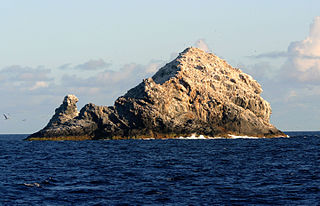
The Gardner Pinnacles are two barren rock outcrops surrounded by a reef and located in the Northwestern Hawaiian Islands.

Necker Island is a small uninhabited island in the Northwestern Hawaiian Islands. It is located at 23°34′30″N164°42′01″W in the Pacific Ocean, 430 miles northwest of Honolulu, Hawaii, 155 miles northwest of Nihoa, and 8 miles north of the Tropic of Cancer. It is part of the state of Hawaii in the United States. It contains important prehistoric archaeological sites of the Hawaiian culture and is part of the Hawaiian Islands National Wildlife Refuge within the Papahānaumokuākea Marine National Monument.
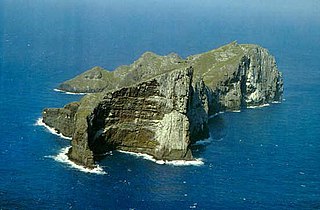
Nihoa, also known as Bird Island or Moku Manu, is the tallest of ten islands and atolls in the uninhabited Northwestern Hawaiian Islands (NWHI). The island is located at the southern end of the NWHI chain, 296 km (160 nmi) southeast of Necker Island. Nihoa is the closest NWHI in proximity to the eight main windward Hawaiian Islands at approximately 240 km (130 nmi) northwest of the island of Kauaʻi. The island has two peaks, 272 m (892 ft) Miller's Peak in the west, and 259 m (850 ft) Tanager Peak in the east. Nihoa's area is about 171 acres (0.69 km2) and is surrounded by a 142,000-acre (57,000 ha) coral reef. Its jagged outline gives the island its name, Nīhoa, which is Hawaiian for "toothed, serrated".
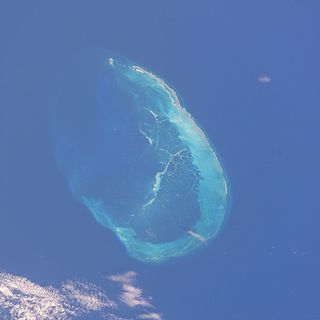
The French Frigate Shoals is the largest atoll in the Northwestern Hawaiian Islands. Its name commemorates French explorer Jean-François de Galaup, comte de Lapérouse, who nearly lost two frigates when attempting to navigate the shoals. It consists of a 20-mile-long (32 km) crescent-shaped reef, twelve sandbars, and the 120-foot-high (37 m) La Perouse Pinnacle, the only remnant of its volcanic origins. The total land area of the islets is 61.508 acres (24.891 ha), while the total coral reef area of the shoals is over 232,000 acres (94,000 ha). Tern Island, with an area of 26.014 acres (10.527 ha), has a landing strip and permanent habitations for a small number of people. It is maintained as a field station in the Hawaiian Islands National Wildlife Refuge by the United States Fish and Wildlife Service. The French Frigate Shoals are about 487 nautical miles northwest of Honolulu. Among the shoals are Tern, which is unique in having an airstrip and is protected by a seawall, and La Perouse Pinnacle, a tall and rocky island in the center of the shoals. The two largest islands after Tern, East and Trig, have mostly washed away, with East being about half the size from storms, but are famed as breeding grounds for turtles. East was also home to Coast Guard base in the late 20th century. The islands are surrounded by a coral reef, and the islands themselves are noted breeding ground for turtles, seals, and birds. Habitation is difficult with little vegetation and no fresh water. The French Frigate Shoals are also called Lalo as part of the marine nature reserve, and along with other islands are visited periodically for research. The highest point in the shoals is on La Perouse Pinnacle, which is a volcanic rock that rises 122 ft (37 m) above the surrounding lagoon.

The Northwestern Hawaiian Islands also known as the Leeward Hawaiian Islands, are a series of islands and atolls located northwest of Kauai and Niʻihau in the Hawaiian island chain. Politically, these islands are part of Honolulu County in the U.S. state of Hawaii, with the exception of Midway Atoll. Midway Atoll is a territory distinct from the State of Hawaii, and is classified as one of the United States Minor Outlying Islands. The United States Census Bureau designates this area, excluding Midway Atoll, as Census Tract 114.98 of Honolulu County. The total land area of these islands is 3.1075 square miles. With the exception of Nihoa, all these islands lie north of the Tropic of Cancer, making them the only islands in Hawaii situated outside the tropics.

The Pearl and Hermes Atoll, also known as Pearl and Hermes Reef, is part of the Northwestern Hawaiian Islands, a group of small islands and atolls that form the farthest northwest portion of the Hawaiian island chain. The atoll consists of a variable number of flat and sandy islets, typically between five and seven. More were noted in historical sources but have since been lost to erosion and rising sea levels.

Laysan is one of the Northwestern Hawaiian Islands, located 808 nautical miles northwest of Honolulu. It has one land mass of 1,016 acres (411 ha), about 1 by 1+1⁄2 miles in size. It is an atoll of sorts, although the land completely surrounds Laysan Lake, some 2.4 m (7.9 ft) above sea level, that has a salinity approximately three times greater than the ocean. Laysan's Hawaiian name, Kauō, means "egg".

The Laysan albatross is a large seabird that ranges across the North Pacific. The Northwestern Hawaiian Islands are home to 99.7% of the population. This small gull-like albatross is the second-most common seabird in the Hawaiian Islands, with an estimated population of 1.18 million birds, and is currently expanding its range to new islands. The Laysan albatross was first described as Diomedea immutabilis by Lionel Walter Rothschild, in 1893, on the basis of a specimen from Laysan Island.

The Papahānaumokuākea Marine National Monument (PMNM) is a World Heritage listed U.S. national monument encompassing 583,000 square miles (1,510,000 km2) of ocean waters, including ten islands and atolls of the Northwestern Hawaiian Islands. It was created in June 2006 with 140,000 square miles (360,000 km2) and expanded in August 2016 by moving its border to the limit of the exclusive economic zone, making it one of the world's largest protected areas. It is internationally known for its cultural and natural values as follows:
The area has deep cosmological and traditional significance for living Native Hawaiian culture, as an ancestral environment, as an embodiment of the Hawaiian concept of kinship between people and the natural world, and as the place where it is believed that life originates and to where the spirits return after death. On two of the islands, Nihoa and Mokumanamana, there are archaeological remains relating to pre-European settlement and use. Much of the monument is made up of pelagic and deepwater habitats, with notable features such as seamounts and submerged banks, extensive coral reefs and lagoons.

La Perouse Pinnacle is a steep basalt outcrop at French Frigate Shoals in the Pacific Ocean. Rising approximately 122 ft (37 m) above sea surface, it is the eroded plug of a shield volcano and caldera that formed 12 million years ago. The rocky formation lies within the Papahānaumokuākea Marine National Monument. Because of its prominence and shape, the pinnacle can be mistaken for a sailing ship from a distance.

Hurricane Neki was the final tropical cyclone of the 2009 Pacific hurricane season. It developed on October 18 as an unusually large disturbance from a trough south of Hawaii. Moving northwestward, it organized only slowly at first due to its large size. After reaching hurricane status on October 21, Neki intensified at a much faster rate and peaked with winds of 125 mph (205 km/h). It later turned to the north and north-northeast and weakened due to hostile conditions. While passing through the Papahānaumokuākea Marine National Monument, Neki was downgraded to a tropical storm after the center became exposed from the deepest convection. It caused little impact in the island chain. After stalling and executing a small loop, Neki resumed its northward track and dissipated on October 27.

Two Brothers was a Nantucket whaleship that sank on the night of February 11, 1823, off the French Frigate Shoals. The ship's captain was George Pollard, Jr., former captain of the famous whaleship Essex. The wreck was discovered in 2008 by a team of marine archaeologists working on an expedition for the National Oceanic and Atmospheric Administration in the Papahānaumokuākea Marine National Monument. She is thought to have been built in 1804 by Joseph Glidden in Hallowell, Maine.
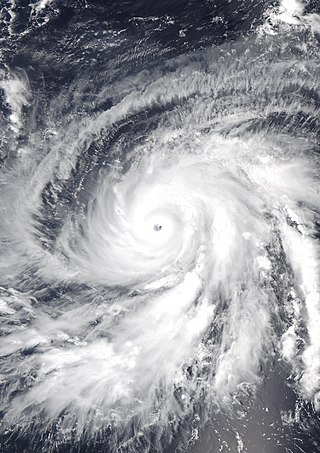
Hurricane Walaka was a strong tropical cyclone that brought high surf and a powerful storm surge to the Northwestern Hawaiian Islands. Walaka was the nineteenth named storm, twelfth hurricane, eighth major hurricane, and second Category 5 hurricane of the 2018 Pacific hurricane season.

East Island is an island, formerly about 11 acres (45,000 m2) in area, one-half mile (800 m) long and 400 feet (120 m) wide, now greatly reduced in size. It was the second-largest in the French Frigate Shoals, and is one of the Northwestern Hawaiian Islands, approximately 550 miles (890 km) northwest of Honolulu. It was largely washed away in 2018 by the storm surge from Hurricane Walaka. The remaining portion of the island above sea level consists of a sandy strip approximately 150 feet (46 m) long.

The Northwestern Hawaii scrub is a tropical and subtropical grasslands, savannas, and shrublands ecoregion on the Northwestern Hawaiian Islands in the Pacific Ocean.

US FWS Henry O'Malley was an American fisheries science research vessel in commission from 1949 to 1951 in the fleet of the United States Department of the Interior's Fish and Wildlife Service. She was the first U.S. fisheries science vessel to explore the central Pacific Ocean in search of commercially valuable populations of fish. Her career was cut short by a requirement for cost-prohibitive repairs.


